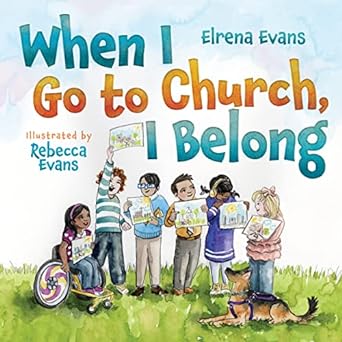My big sister has Down Syndrome. My early years were immersed in the world of her therapies and classes through early intervention, which was a brand-new thing in the late 70s. I never knew that other families did NOT live lives regulated by bus schedules, push-in therapists, play therapies, and more. When we started public school together, we attended in the same school district, but I walked to the elementary school down the block while Sarah got on a little bus that ferried her to her classroom across town. I couldn’t understand why she was at a different school and why she got to go all day when I only got to be there for a few hours. What did I do wrong? And then I started talking with classmates and NO ONE else lived a life like mine. And in the early 80s, there was not much support for, conversation about, or representation of the lives of those with disabilities. I was a bit unmoored.
When I Go to Church, I Belong seeks to show readers what the beloved community can be when we think about the different ways we can include others. The story is told through beautiful prose, illuminating different ways one congregation has set up their ministries for inclusion of those that come. We see children gathered around a table working on a project together; the focus is on the group, but we are given glimpses of a service dog at one child’s feet and a table that is positioned properly so a little one in a wheelchair can roll right in and be part of the gathering. We hear about a child who feels scared with larger gatherings and louder sounds, finding herself in a sensory friendly room where the service is livestreamed and she is able to participate in an environment that is comforting. We see a playground that includes a ramp, tables at fellowship that include a variety of dietary options to welcome those who need gluten free, tree nut free, and dairy free foods. We see an ASL interpreter, a dance space, and classroom buddies to help those that need support. Throughout the book, we see a congregation that is committed to inclusion of all of God’s children through their staffing, building, and other ministry decisions. The focus is on welcoming, not on the challenge of adapting. If I had seen a book like this as a child, I would have swooned. My sister would have, too. Yes, this book helps those with various disabilities find someone that can help represent them. But it also gives families a voice, as well as showing congregations different ways to expand the circle and draw more of God’s beloved people into the community.
When I Go To Church, I Belong is a versatile title to keep on your shelves. It’s a great reinforcement for when your readings in church and faith formation brings you to conversations about the parts of the body all being important to the whole. It’s a wonderful tie-in to lessons around who is called to be part of God’s family. You can read it in faith formation, you can share it during bedtime stories and prayers, you can even use it in your children’s moment. Pop in your pew baskets. Keep a copy in your lending library. But what if you brought this book to your education or worship committees to help them discern what their callings are for the people God has sent to you? What if your administrative board used this book to guide their prayers for a few months, especially during a season of discernment? What seeds would be planted and nurtured? This little book packs more into it than you would think. I would definitely make space on your shelves (but, better yet, your coffee table, your altar steps, your classroom circle, or your conference room table) for this book.





0 Comments